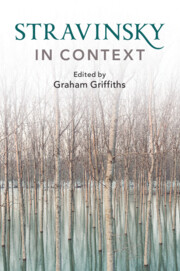Book contents
- Stravinsky in Context
- Composers in Context
- Stravinsky in Context
- Copyright page
- Contents
- Illustrations
- Contributors
- Preface
- Abbreviations
- Frontispiece
- Epigraph
- Part I Russia and Identity
- Part II Stravinsky and Europe
- Part III Partnerships and Authorship
- Part IV Performance and Performers
- Part V Aesthetics and Politics
- Chapter 23 Stravinsky versus Literature
- Chapter 24 Stravinsky and Greek Antiquity
- Chapter 25 Stravinsky’s Response to Japonisme
- Chapter 26 Stravinsky, Modernism and Mass Culture
- Chapter 27 Perspectives on Schoenberg and Stravinsky: Adorno and Others
- Chapter 28 Stravinsky’s ‘Problematic’ Political Orientation during the 1920s and 1930s
- Part VI Reception and Legacy
- Recommendations for Further Reading and Research
- Index
- Endmatter
Chapter 25 - Stravinsky’s Response to Japonisme
from Part V - Aesthetics and Politics
Published online by Cambridge University Press: 03 December 2020
- Stravinsky in Context
- Composers in Context
- Stravinsky in Context
- Copyright page
- Contents
- Illustrations
- Contributors
- Preface
- Abbreviations
- Frontispiece
- Epigraph
- Part I Russia and Identity
- Part II Stravinsky and Europe
- Part III Partnerships and Authorship
- Part IV Performance and Performers
- Part V Aesthetics and Politics
- Chapter 23 Stravinsky versus Literature
- Chapter 24 Stravinsky and Greek Antiquity
- Chapter 25 Stravinsky’s Response to Japonisme
- Chapter 26 Stravinsky, Modernism and Mass Culture
- Chapter 27 Perspectives on Schoenberg and Stravinsky: Adorno and Others
- Chapter 28 Stravinsky’s ‘Problematic’ Political Orientation during the 1920s and 1930s
- Part VI Reception and Legacy
- Recommendations for Further Reading and Research
- Index
- Endmatter
Summary
Compared with The Rite of Spring (1911–13), that splendid masterpiece taking centre stage in the drama of Stravinsky’s life and forming a turning point in it, the short song cycle Three Japanese Lyrics (1912–13), composed during the same period and lasting under four minutes, may appear but a minor work loitering, as it were, backstage. Yet, if we place this composition into the broader cultural context of Japonisme which was so fashionable in Europe at the time, particularly in Paris, it raises several interesting questions. Lyrics has often been recognised as an early example of the impact of Japonisme on modern music, but what traces of ‘Japanese style’ does this work reveal?
- Type
- Chapter
- Information
- Stravinsky in Context , pp. 222 - 229Publisher: Cambridge University PressPrint publication year: 2020

